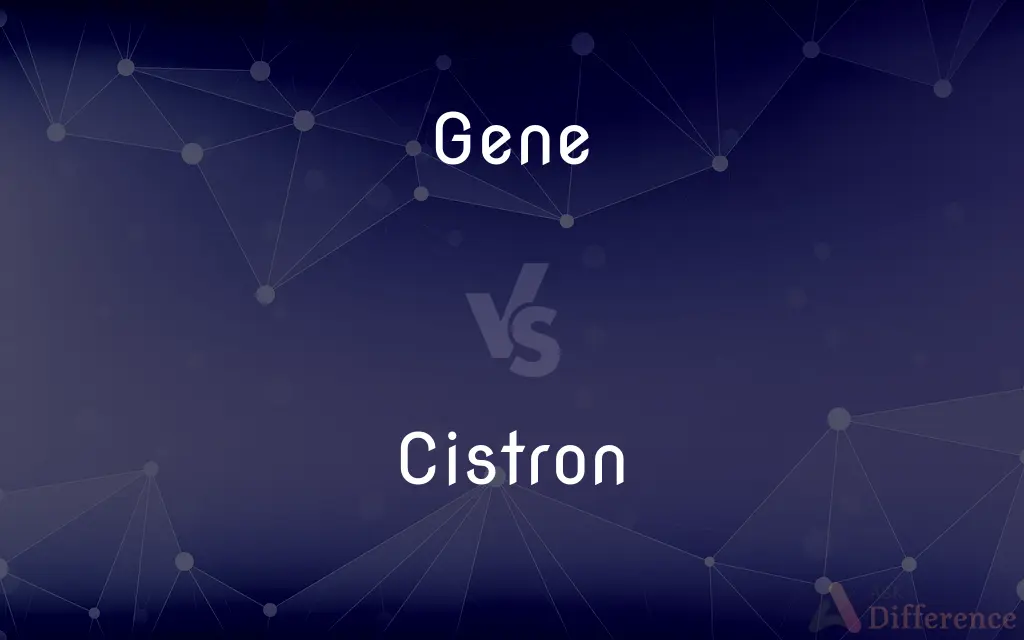Gene vs. Cistron — What's the Difference?
By Fiza Rafique & Maham Liaqat — Updated on March 20, 2024
A gene is a segment of DNA encoding a functional product; a cistron is a gene unit for function, reflecting its ability to be expressed as a phenotype.

Difference Between Gene and Cistron
Table of Contents
ADVERTISEMENT
Key Differences
A gene represents the fundamental unit of heredity in living organisms, encoding the information necessary for the synthesis of proteins and RNA molecules. These entities play critical roles in the development, functioning, and reproduction of organisms. Cistrons, on the other hand, are specifically defined by their function in the expression of a particular trait or phenotype, emphasizing the aspect of gene expression and regulation.
Genes are located on chromosomes and contain both coding sequences that determine the structure of proteins and non-coding sequences that play roles in gene regulation. Cistrons are a functional concept that arose from the understanding of how genes work in conjunction, particularly through the study of bacterial genetics and the operon model, focusing on the expression of genes into functional products.
In the broader context of genetics, all cistrons are genes, but not all genes are considered cistrons in a functional sense. This distinction highlights the functional aspect of cistrons, which is their ability to be expressed as a distinct phenotype, whereas genes might contain both coding and regulatory regions affecting gene expression.
The concept of a gene encompasses a wider range of functions, including coding for proteins, RNAs, and playing roles in regulation and structural support within chromosomes. Cistrons, by focusing specifically on the aspect of gene function that can be linked directly to a phenotype, provide a more nuanced understanding of gene expression.
The distinction between genes and cistrons reflects the evolution of genetic understanding, moving from a broader concept of heredity and physical units within DNA to a more refined focus on gene function and expression. This differentiation is crucial for geneticists and molecular biologists in exploring how genetic information translates into physical traits.
ADVERTISEMENT
Comparison Chart
Definition
A segment of DNA encoding a functional product, including proteins and RNAs.
A gene unit defined by its function in phenotype expression.
Focus
Encodes information for development, functioning, and reproduction.
Specifically involved in the expression of a trait or phenotype.
Composition
Includes coding and non-coding sequences.
Primarily considered for its coding sequence in relation to function.
Genetic Concept
Broader concept encompassing various functions.
Focused on the expression and regulation of specific traits.
Relationship to Phenotype
May or may not directly correlate with a phenotype.
Directly correlates with a phenotype through expression.
Compare with Definitions
Gene
A part of the DNA in a cell that controls the physical development, behavior, etc., of an individual organism.
Genetic engineering involves modifying genes for desired traits.
Cistron
A functional unit of genetic material that corresponds to a segment of DNA coding for one polypeptide.
Each cistron's expression can be independently regulated.
Gene
A unit of heredity that is transferred from a parent to offspring and is held to determine some characteristic of the offspring.
The gene responsible for eye color has been extensively studied.
Cistron
In genetic terminology, a synonym for gene, used specifically to emphasize its function.
The concept of the cistron helps clarify the functional aspects of genetics.
Gene
The molecular unit of heredity in living organisms.
Scientists study genes to understand hereditary diseases.
Cistron
A DNA segment that expresses a specific phenotype when mutated, showing the direct link between genes and traits.
Mutations in a cistron can lead to observable changes in the organism's phenotype.
Gene
Genes are located on chromosomes and can be replicated, transcribed, and translated.
The process by which genes are expressed involves transcription and translation.
Cistron
The term used in molecular genetics to refer to a segment of DNA that codes for a single peptide in an operon.
Bacterial operons are divided into multiple cistrons.
Gene
A segment of DNA involved in producing a polypeptide chain; it includes regions preceding and following the coding region as well as introns between the exons.
The structure of genes includes both exons and introns.
Cistron
A section of DNA that codes for a single specific polypeptide; can be functionally defined through the cis-trans test.
The cistron is a fundamental unit in the functional analysis of genes.
Gene
In biology, a gene (from genos (Greek) meaning generation or birth or gender) is a basic unit of heredity and a sequence of nucleotides in DNA or RNA that encodes the synthesis of a gene product, either RNA or protein.During gene expression, the DNA is first copied into RNA. The RNA can be directly functional or be the intermediate template for a protein that performs a function. The transmission of genes to an organism's offspring is the basis of the inheritance of phenotypic traits.
Cistron
A cistron is an alternative term for "gene". The word cistron is used to emphasize that genes exhibit a specific behavior in a cis-trans test; distinct positions (or loci) within a genome are cistronic.
Gene
(in informal use) a unit of heredity which is transferred from a parent to offspring and is held to determine some characteristic of the offspring
Playing tennis is in my genes
Cistron
A section of DNA that contains the genetic code for a single polypeptide and functions as a hereditary unit.
Gene
A hereditary unit consisting of a sequence of DNA that occupies a specific location on a chromosome and is transcribed into an RNA molecule that may function directly or be translated into an amino acid chain. Genes undergo mutation when their DNA sequences change.
Cistron
The unit of hereditary material (e.g. DNA) that encodes one protein; sometimes used interchangeably with the word gene.
Gene
(genetics) A theoretical unit of heredity of living organisms; a gene may take several values and in principle predetermines a precise trait of an organism's form (phenotype), such as hair color.
Cistron
(genetics) a segment of DNA that is involved in producing a polypeptide chain; it can include regions preceding and following the coding DNA as well as introns between the exons; it is considered a unit of heredity;
Genes were formerly called factors
Gene
(molecular biology) A segment of DNA or RNA from a cell's or an organism's genome, that may take several forms and thus parameterizes a phenomenon, in general the structure of a protein; locus.
A change in a gene is reflected in the protein or RNA molecule that it codes for.
Gene
(genetics) a segment of DNA that is involved in producing a polypeptide chain; it can include regions preceding and following the coding DNA as well as introns between the exons; it is considered a unit of heredity;
Genes were formerly called factors
Common Curiosities
Can a gene contain multiple cistrons?
Yes, especially in prokaryotes where operons may contain multiple cistrons that are transcribed together but function independently.
What is a gene?
A gene is a segment of DNA that contains the information needed to produce proteins and RNAs, which are essential for the organism's development and functioning.
What is a cistron?
A cistron is a segment of DNA that functions as a unit in gene expression, directly contributing to a phenotype.
Why is the concept of cistrons important?
Cistrons emphasize the functional aspects of gene expression and its direct impact on phenotype, useful in genetic and molecular biology studies.
How do mutations affect genes and cistrons?
Mutations can alter the function of both genes and cistrons, potentially leading to changes in phenotype or disease.
How do scientists study genes and cistrons?
Scientists use genetic sequencing, functional assays, and molecular biology techniques to study the structure, function, and expression of genes and cistrons.
What impact do genes and cistrons have on genetic engineering?
Understanding genes and cistrons is crucial for genetic engineering efforts aimed at modifying organisms for beneficial traits or disease resistance.
How do genes differ from cistrons?
While all cistrons are genes, focusing on their function in phenotype expression, not all genes are cistrons. Genes include both coding and regulatory sequences.
What role do genes play in heredity?
Genes are the basic units of heredity, passing genetic information from parents to offspring, influencing traits and diseases.
Are cistrons relevant in human genetics?
Yes, the concept of cistrons is relevant in understanding the expression of genes in humans and the relationship between genetic mutations and phenotypes.
How are genes and cistrons identified?
Genes and cistrons are identified through genetic sequencing and functional studies, such as the cis-trans test for cistrons.
What is the relationship between genes, cistrons, and proteins?
Genes encode for proteins, and cistrons are functional units within genes that ensure the expression of these proteins, reflecting their direct role in phenotype.
Can the function of a gene change over time?
Yes, through evolution and mutations, the function of genes can change, affecting the organism's traits and adaptability.
Share Your Discovery

Previous Comparison
Pulley vs. Trolley
Next Comparison
Caribe vs. PiranhaAuthor Spotlight
Written by
Fiza RafiqueFiza Rafique is a skilled content writer at AskDifference.com, where she meticulously refines and enhances written pieces. Drawing from her vast editorial expertise, Fiza ensures clarity, accuracy, and precision in every article. Passionate about language, she continually seeks to elevate the quality of content for readers worldwide.
Co-written by
Maham Liaqat












































